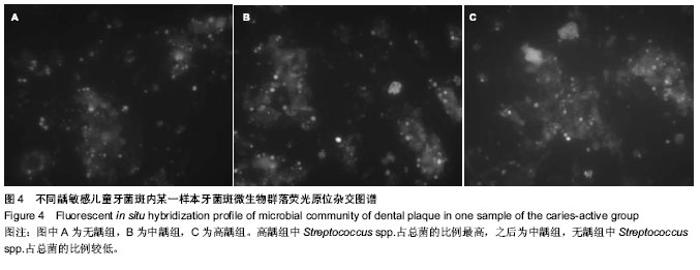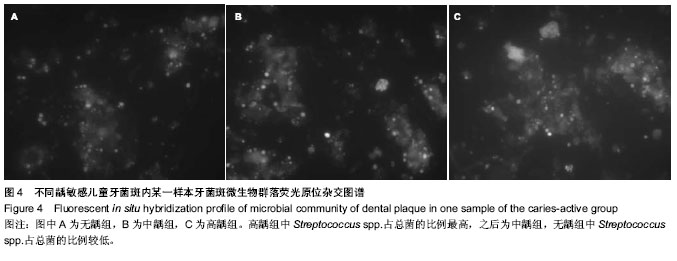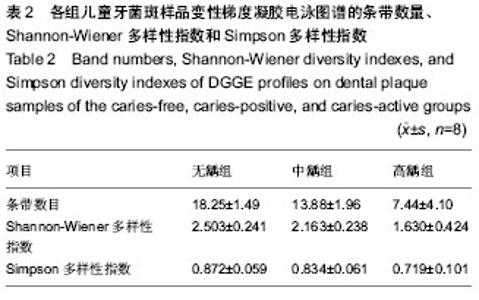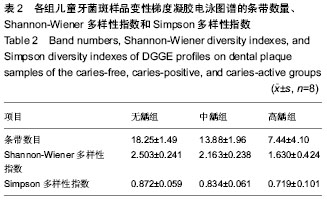Chinese Journal of Tissue Engineering Research ›› 2014, Vol. 18 ›› Issue (25): 4043-4050.doi: 10.3969/j.issn.2095-4344.2014.25.019
Previous Articles Next Articles
Molecular ecology of microbial communities in dental plaques of different caries-susceptible children
Liu Li-xia1, Chen Lin2
- 1Department of Stomatology, Second People’s Hospital of Shenzhen, Shenzhen 518035, Guangdong Province, China; 2Jinjue Dental Institute of Jiamusi, Jiamusi 154002, Heilongjiang Province, China
-
Received:2014-05-13Online:2014-06-18Published:2014-06-18 -
Contact:Chen Lin, Attending physician, Jinjue Dental Institute of Jiamusi, Jiamusi 154002, Heilongjiang Province, China -
About author:Liu Li-xia, Attending physician, Department of Stomatology, Second People’s Hospital of Shenzhen, Shenzhen 518035, Guangdong Province, China
CLC Number:
Cite this article
Liu Li-xia, Chen Lin. Molecular ecology of microbial communities in dental plaques of different caries-susceptible children[J]. Chinese Journal of Tissue Engineering Research, 2014, 18(25): 4043-4050.
share this article
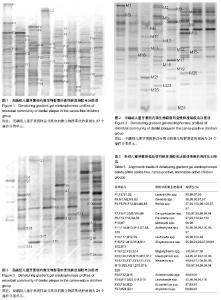
2.1 不同龋敏感儿童GIC表面牙菌斑内微生物群落结构分析 采用变性梯度凝胶电泳技术分析不同龋敏感儿童牙菌斑内的微生物群落结构,结果如图1-3所示。结果表明:无龋组、中龋组和高龋组牙菌斑样品经变性梯度凝胶电泳分析后均分离出数目不等的电泳条带,每个独立分离的条带可认为是一个操作分类单元(operational taxonomy unit,OTU)。无龋组儿童牙菌斑样品分离出的微生物群落优势菌属为37个OTUs,显著高于中龋组(24个OTUs)和高龋组(21个OTUs),说明无龋组牙菌斑样品中微生物种类显著多于中龋组和高龋组。对这3组牙菌斑样品中,变性梯度凝胶电泳图谱显示均出现了某些微生物的大量富集现象。"
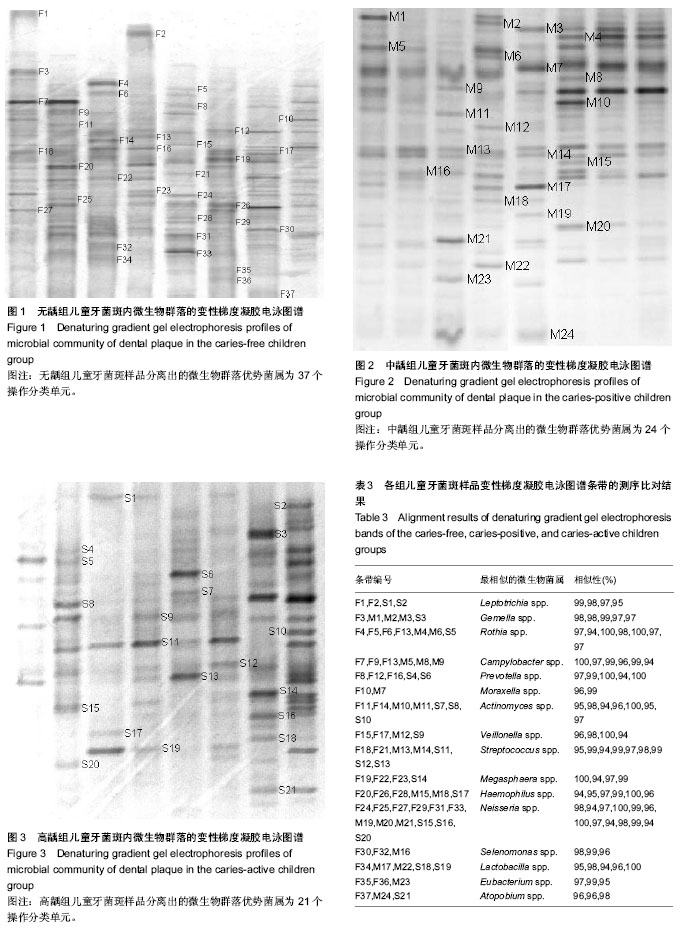
| [1] 王瑾,程为庄.玻璃离子水门汀的研究进展[J].北京生物医学工程, 2005,24(2):139-143. [2] Forsten L.Resin-modified glass-ionomer cements fluoride release and uptake. Acta Odonto Scand.1995;53:222-225. [3] Aas JA,Paster BJ,Stokes LN,et al.Defining the normal bacterial flora of the oral cavity.J Clin Microbiol. 2005;43(11): 5721-5732. [4] Marsh PD,Bradshaw DJ.Physiological approaches to the control of oral biofilms. Adv Dent Res.1997;11(1):176-185. [5] Beighton D.The complex oral microflora of high risk individuals and groups and its role in the caries process. Community Dent Oral Epidemiol. 2005;33(4);248-255. [6] Pennisi E.A mouthful of microbes. Science. 2005;307(5717): 1899-1901. [7] Li J,Helmerhorst EJ,Leone CW,et al.Identification of early microbial colonizers in human dental biofilm.J Appl Microbiol. 2004;97(6):1311-1318. [8] Cowan D,Meyer Q,Staff rd W,et al.Metagenomic gene discovery: Past, present and future.Trends Biotechnol. 2005; 23(6):321-329. [9] Muyzer G,Smalla K.Application of denaturing gradient gel electrophoresis (DGGE) and temperature gradient gel electrophoresis (TGGE) in microbial ecology. Antonie Van Leeuwenhoek.1998;73(1):127-141. [10] Palmer C,Bik EM,Eisen MB.Rapid quantitative profiling of complex microbial populations.Nucleic Acids Res. 2006; 34(1):e5. [11] World Health Organization.Oral health surveys Basic Methods. 4th ed. Geneva: World Health Organization. 1997: 1-21. [12] Nuebel U,Engelen B,Felske A.Sequence heterogeneities of genes encoding 16S rRNAs in paenibacillus polymyxa detected by temperature gradient gel electrophoresis. J Bacteriol.1996;178:5636-5643. [13] 刘靖,王韦玮,胡凡,等.荧光原位杂交观察口腔原位菌斑中链球菌和具核梭杆菌的动态变化的研究[J].口腔医学, 2012,32(1): 15-18. [14] 梁景平,姜云涛,李超伦,等.实时PCR技术在龋易感儿童牙菌斑致龋菌定量检测中的应用[J].上海交通大学学报:医学版, 2007, 27(2):128-132. [15] Ledder RG,Gilbert P,Pluen A,et al.Individual microflora beget unique oral microcosms.J Clin Microbiol.2006;1123-1131. [16] Ruby J,Goldner M.Nature of symbiosis in oral disease.J Dent Res.2007;(1):8. [17] McBain AJ,Bartolo RG,Catrenich CE,et al.Growth and molecular characterization of dental plaque microcosms.J Appl Microbiol.2003;94:655-664. [18] Fujimoto C,Maeda H,Kokeguchi S,et al.Application of denaturing gradient gel electrophoresis (DGGE) to the analysis of microbial communities of subgingival plaque. J Periodont Res.2003;38:440-445. [19] Rudney JD,Pan Y,Chen R.Streptococcal diversity in oral biofilms with respect to salivary function.Arch Oral Biol. 2003; 48:475-493. [20] Rasiah IA,Wong L,Anderson SA,et al.Variation in bacterial DGGE patterns from human saliva: over time,between individuals and in corresponding dental plaque microcosms. Arch Oral Biol.2005;50:779-787. [21] Li Y,Saxena D,Barnes VM,et al.Polymerase chain reaction- based denaturing gradient gel electrophoresis in the evaluation of oral microbiota.Oral Microbiol Immunol. 2006;21:333-339. [22] Li Y,Ku CYS,Xu J,et al.Survey of oral microbial diversity using PCR-based denaturing gradient gel electrophoresis.J Dent Res.2005;84(6):559-564. [23] 姜云涛,梁景平,李超伦,等.不同龋敏感儿童牙菌斑内口腔链球菌的PCR-DGGE分析[J].上海交通大学学报:医学版, 2007,27(2): 133-136. [24] Li Y,Ismail AI,Ge Y,et al.Similarity of bacterial populations in saliva from African-American mother-child dyads.J Clin Microbiol.2007;45(9):3082-3085. [25] Rocas IN,Siqueira JF,Aboim MCR et al.Denaturing gradient gel electrophoresis analysis of bacterial communities associated with failed endodontic treatment. Oral Surg Oral Med Oral Pathol Oral.2004;98(6):741-749. [26] Siqueira JF,Rocas IN,Rosado AS.Investigation of bacterial communities associated with asymptomatic and symptomatic endodontic infections by denaturing gradient gel electrophoresis fingerprinting approach.Oral Microbiol Immunol. 2004;19:363-370. [27] Machado de Oliveira JC,Siqueira JF,Rocas IN,et al.Bacterial community profiles of endodontic abscesses from Brazilian and USA subjects as compared by denaturing gradient gel electrophoresis analysis.Oral Microbiol Immunol. 2007;22: 14-18. [28] Paster BJ,Boches SK,Galvin JL,et al.Bacterial diversity in human subgingival plaque.J Bacteriol. 2001;183(12): 3770-3783. [29] Zijnge V,Harmsen HJM,Kleinfelder JW,et al.Denaturing gradient gel electrophoresis analysis to study bacterial community structure in pockets of periodontitis patients.Oral Microbiol Immunol.2003;18:59-65. [30] Ledder RG,Gilbert P,Huws SA,et al.Molecular analysis of the subgingival microbiota in health and disease.Appl Environ Microb.2007;73(2):516-523. [31] 于淼,仪虹,孟玲娜,等.不同龋状况母子间口腔微生物群落结构分析[J].口腔医学研究,2010,26(3):387-390. [32] Loesche WJ.The specific plaque hypothesis and the antimicrobial treatment of periodontal disease.Dent Update. 1992;19:68-74. [33] Marsh PD.Microbial ecology of dental plaque and its signifcance in health and disease.Adv Dent Res. 1994;8: 263-271. [34] Li Y,Ge Y,Saxena D,et al.Genetic profiling of the oral microbiota associated with severe early-childhood caries.J Clin Microbiol.2007;45(1):81-87. [35] 刘怡然,王伟健,沈家平,等.PCR-DGGE 检测早期儿童龋治疗前后口腔菌群多样性的初步研究[J].口腔生物医学, 2012,3(4): 201-204. [36] Sbordone L,Bortolaia C.Oral microbial biofilms and plaque-relateddiseases: microbial communities and their role in the shift from oralhealth to disease.Clin Oral Invest. 2003; 7(4):181-188. [37] Bradshaw DJ,Marsh PD.Analysis of pH-driven disruption of oral microbial communities in vitro.Caries Res. 1998;32(6): 456-462. [38] Chalmers N,Palmer Jr RJ,Cisar JO,et al.Characterization of a Streptococcus sp.-Veillonella sp. community micromanipulated from dental plaque.J Bacteriol. 2008;190 (24): 8145-8154. [39] Choi EJ,Lee SH,Kim YJ.Quantitative real-time polymerase chain reaction for Streptococcus mutans and Streptococcus sobrinus in dental plaque samples and its association with early childhood caries.Int J Paediatr Dent.2009;19(2): 141-147. [40] Kreth J,Merritt J,Shi W,et al.Competition and coexistence betweenStreptococcus mutans and Streptococcus sanguinis in the dental biofilm.J Bacteriol.2005;187(21):7193-7203. [41] Aas JA,Griffen AL,Dardis SR,et al.Bacteria of dental caries in primary and permanent teeth in children andyoung adults.J Clin Microbiol.2008;46(4):1407-1417. [42] Dige I,Raarup MK,Nyengaard JR,et al. Actinomyces naeslundiiin initial dental biofilm formation. Microbiol. 2009; 155(Pt 7):2116-2126. [43] Ruby JD,Shirey RE,Gerencser VF.Extracellular iodophilic polysaccharide synthesized by Neisseria in human dental plaque.J Dent Res.1982;61(5):627-631. [44] Willcox MD,Drucker DB,Hillier VF.Cohesion between oral streptococci and Neisseria pharyngis on saliva-coated glass, in the presence and absence of sucrose. Microbiol. 1990; 61(248-249):197-205. [45] Egland PG,Palmer RJ,Kolenbrander PE.Interspecies communication inStreptococci gordonii - Veillonella atypical biofilms: Signaling in flow conditions requires juxtaposition. Proc N Acad Sci.2004;101(48):16917-16922. [46] Arif N,Sheehy EC,Do T, et al. Diversity of Veillonella spp. from sound and carious sites in children.J Dent Res. 2008;87(3): 278-282. [47] Chhour KL,Nadkarni MA,Byun R,et al.Molecular analysis of microbial diversity in advanced caries.J Clin Microbiol. 2005; 43(2):843-849. [48] Koga T,Oho T,Shimazaki Y,et al.Immunization against dental caries. Vaccine.2002;20(16):2027-2044. [49] Kuramitsu HK.Virulence properties of oral bacteria: impact of molecular biology. Curr Issues Mol Biol.2001;3(2):35-36. [50] Aguilera Galaviz LA,AcevesMedina Mdel C,Estrada Garcia IC.Detection of potentially cariogenic strains of Streptococcus mutans using the polymerase chain reaction.J Clin Pediatr Dent.2002;27(1):47-51. [51] Durán-Contreras GL,Torre-Martínez HH,de la Rosa EI,et al.spaP gene of Streptococcus mutans in dental plaque and its relationship with early childhood caries.Eur J Paediatr Dent. 2011;12(4):220-224. [52] Acevedo AM,Ray MV,Socorro M,et al.Frequency and distribution of Mutans Streptococci in dental plaque from caries-free and caries-affected Venezuelan children.Acta Odontol Latinoam.2009;22(1):15-20. [53] Kishi M,Abe A,Kishi K,et al.Relationship of quantitative salivary levels of Streptococcus mutans and S. sobrinus in mothers to caries status and colonization of mutans streptococci in plaque in their 2.5-year-old children. Community Dent Oral Epidemiol.2009;37(3):241-249. [54] Okada M,Soda Y,Hayashi F,et al.PCR detection of Streptococcus mutans and S. sobrinus in dental plaque samples from Japanese pre-school children.J Med Microbiol. 2002;51(5):443-447. [55] Franco e Franco TC,Amoroso P,Marin JM,et al.Detection of Streptococcus mutans and Streptococcus sobrinus in dental plaque samples from Brazilian preschool children by polymerase chain reaction.Braz Dent J.2007;18(4):329-333. [56] Zhi QH,Lin HC,Zhang R,et al.Arbitrarily primed-PCR detection of Streptococcus mutans and Streptococcus sobrinus in dental plaque of children with high dmft and no caries.Zhonghua Kou Qiang Yi Xue Za Zhi.2007;42(4): 219-222. [57] Psoter WJ,Ge Y,Russell SL,et al.PCR detection of Streptococcus mutans and Aggregatibacter actinomycetemcomitans in dental plaque samples from Haitian adolescents.Clin Oral Investig.2011;15(4):461-469. [58] Loyola-Rodriguez JP,Martinez-Martinez RE,Flores-Ferreyra BI,et al.Distribution of Streptococcus mutans and Streptococcus sobrinus in saliva of Mexican preschool caries-free and caries-active children by microbial and molecular (PCR) assays.J Clin Pediatr Dent.2008;32(2): 121-126. |
| [1] | Wang Ning, Zhong Weijian. Application and function of autologous blood concentrate in tissue regeneration [J]. Chinese Journal of Tissue Engineering Research, 2021, 25(1): 146-151. |
| [2] | Zuo Sili. Risk assessment of hemiarthroplasty and internal fixation of proximal femoral nail antirotation for treating hip fractures in older adults [J]. Chinese Journal of Tissue Engineering Research, 2019, 23(28): 4440-4445. |
| [3] | Shao Miaomiao, Liu Zhongxi, Xu Nuo, Liu Qinghua, Wang Dong, He Jianya, Li Xiaojie. Induced pluripotent stem cells in dental tissue regeneration: effect and application [J]. Chinese Journal of Tissue Engineering Research, 2019, 23(1): 151-157. |
| [4] | Liang Fei-zhao, Han Yue, Zhou Yan-ping, Liang Jian-mei, Li Gang. Therapeutic benefit of resin ball filling method for restoration of posterior approximal caries and its influence on periodontal health [J]. Chinese Journal of Tissue Engineering Research, 2018, 22(22): 3480-3484. |
| [5] |
Li Gan, Tong Xin, Qin Hai-yan, Wang Peng-lai.
Short-term effect of titanium abutment versus zirconia abutment on peri-implant tissues in anterior teeth
[J]. Chinese Journal of Tissue Engineering Research, 2017, 21(30): 4811-4816.
|
| [6] | Duan Rui, Li Yong-sheng, Xia Yi-chao. Effects of specific interfering TACC3 gene expression on proliferation and apoptosis of CD133+CD44+ oral squamous cell carcinoma cells [J]. Chinese Journal of Tissue Engineering Research, 2017, 21(25): 3995-4000. |
| [7] | Luo Yi, Jiang Jun-qiang, Dan Hong-ping. A filler synergistic toughening light-curig resin-based dental material: preparation, performance and biomechanical evaluation [J]. Chinese Journal of Tissue Engineering Research, 2017, 21(10): 1489-1494. |
| [8] | Yang Qin-qiu, Dong Lu, Xiao Qiong, Chen Hong-liang, Sun Yong. Establishment of a rabbit model of oral soft tissue defects [J]. Chinese Journal of Tissue Engineering Research, 2016, 20(18): 2684-2689. |
| [9] | Gao Lu, Zhang Xiao-hong, Jin Hai-wei, Cong Wei, Wang Fu. Application of virtual reality technology in oral and maxillofacial anatomy and three-dimensional digital model construction [J]. Chinese Journal of Tissue Engineering Research, 2015, 19(46): 7492-7497. |
| [10] | Wang Cheng-yong, Chen Wei-hui, Lu Meng, Wang Jin, Mao Chuan-qing, Lin Hai. Denervation of the inferior alveolar nerve is associated with bone formation and bone mass maintenance in extraction sockets [J]. Chinese Journal of Tissue Engineering Research, 2015, 19(42): 6740-6745. |
| [11] | Wang Jian-wei, Wang Pu, Lin Bing-peng, Cao Bao-cheng. Antimicrobial properties of TiO2-xNx antibacterial bracket [J]. Chinese Journal of Tissue Engineering Research, 2015, 19(34): 5448-5452. |
| [12] | Huang Xue-hua, He Ke. Influence of three types of toothbrushes on enamel decalcification in orthodontic patients: a comparative study [J]. Chinese Journal of Tissue Engineering Research, 2015, 19(12): 1832-1836. |
| [13] | Li Na, Han Bing, Zhang Qian. Antibacterial properties of inorganic nano-antibacterial materials in orthodontics [J]. Chinese Journal of Tissue Engineering Research, 2015, 19(12): 1953-1957. |
| [14] | Wu Pei-ling, Zhang Xiao-qian, Nijiati Tuerxun, Li Yi-ming. Mucosal perforation in open maxillary sinus lift and dental implantation after restoration [J]. Chinese Journal of Tissue Engineering Research, 2014, 18(51): 8223-8227. |
| [15] | Yao Xi, Li Yun-sheng, Li Hong-mei, Dai Yong-yu. Hyaluronic acid for the treatment of chronic periodontitis can effectively promote periodontal tissue regeneration [J]. Chinese Journal of Tissue Engineering Research, 2014, 18(47): 7648-7652. |
| Viewed | ||||||
|
Full text |
|
|||||
|
Abstract |
|
|||||
